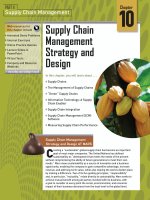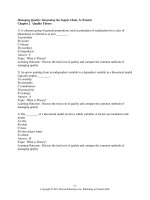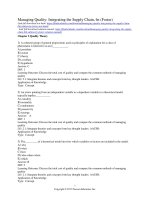Lecture Operations management: Creating value along the supply chain (Canadian edition) - Chapter 8S
Bạn đang xem bản rút gọn của tài liệu. Xem và tải ngay bản đầy đủ của tài liệu tại đây (678.97 KB, 22 trang )
OPERATIONS MANAGEMENT:
Creating Value Along the Supply Chain,
Canadian Edition
Robert S. Russell, Bernard W. Taylor III, Ignacio Castillo, Navneet Vidyarthi
CHAPTER 8 SUPPLEMENT
Work Measurement
Supplement 8-1
Lecture Outline
Time Studies
Work Sampling
Supplement 8-2
Work Measurement
Determining how long it takes to do a job
Growing importance in service sector
Services tend to be labor-intensive
Service jobs are often repetitive
Time studies
Standard time
•
time for average worker to perform a job once
Incentive piece-rate wage system based on time study
Supplement 8-3
Stopwatch Time Study - Steps
1.
2.
3.
4.
5.
Establish standard job method
Break down job into elements
Study job
Rate worker’s performance (RF)
Compute average time (t)
Supplement 8-4
Stopwatch Time Study - Steps
6. Compute normal time
Normal Time = (Elemental average) x (rating factor)
Nt = (t )(RF)
Normal Cycle Time = NT = Nt
7. Compute standard time
Standard Time = (normal cycle time) x (1 + allowance factor)
ST = (NT)(1 + AF)
Supplement 8-5
Performing a Time Study
Time Study Observation Sheet
Identification of operation
Date
Sandwich Assembly
Operator
Smith
Approval
Jones
Observer
Russell
Cycles
1
Grasp and lay
1 out bread slices
Spread mayonnaise
2 on both slices
3
Place ham, cheese,
and lettuce on bread
4
Place top on sandwich,
Slice, and stack
t
2
3
4
5
6
Summary
7
8
9
10
.04 .05 .05 .04 .06 .05 .06 .06 .07 .05
R .04
.38 .72 1.05 1.40 1.76 2.13 2.50 2.89 3.29
t .07
.06
R .11
.44 .79 1.13 1.47 1.83 2.21 2.60 2.98 3.37
t .12
.11
.07 .08 .07 .07
.14
.12
.13
.13
.08
.13
.10
.12
.09
.14
.08
.93 1.25 1.60 1.96 2.34 2.72 3.12 3.51
t .10
.12
.08
R .33
.67 1.01 1.34 1.71 2.07 2.44 2.82 3.24 3.61
.11
.11
.10
.10
.12
t
t
RF
Nt
.53 .053 1.05 .056
.77 .077 1.00 .077
.14 1.28 1.28 1.10 .141
R .23 .55
.09
5/17
.10 1.03 1.03 1.10 .113
Supplement 8-6
Performing a Time Study
Average element time = t =
0.53
Σt
=
= 0.053
10
10
Normal time = (Elemental average)(rating factor)
Nt = ( t )(RF) = (0.053)(1.05) = 0.056
Normal Cycle Time = NT =
Nt = 0.387
ST = (NT) (1 + AF) = (0.387)(1+0.15) = 0.445 min
Supplement 8-7
Performing a Time Study
How many sandwiches can be made in 2 hours?
120 min
0.445 min/sandwich
= 269.7 or 270 sandwiches
Supplement 8-8
Incentive Piece-Rate System
Average worker makes 135 sandwiches per hour
60 min
0.445 min/sandwich
= 134.8 or 135 sandwiches
Average hourly wage rate is
135 x 0.04 = $5.40
Supplement 8-9
Example Worker Wages
Observed worker average cycle time = 0.361, no RF
0.361 x (1+0.15) = 0.414 min
60 min
0.415 min/sandwich
= 144.6 or 145 sandwiches
Average hourly wage rate is
145 x 0.04 = $5.80
Supplement 8-10
Time Study With Excel
Supplement 8-11
Number of Cycles
Computing number of job cycles to observe:
n=
zs
eT
2
where
z=
number of standard deviations from the mean
in a normal distribution reflecting a level of statistical
confidence
sΣ(xi
= - x)2
n-1
T=
study
e=
= sample standard deviation from
sample time study
average job cycle time from the sample time
degree of error from true mean of distribution
Supplement 8-12
Number of Cycles
•
•
•
Average cycle time = 0.361
Computed standard deviation = 0.03
Company wants to be 95% confident that computed time is within 5%
of true average time
zs
neT
=
2
=
(1.96)(0.03)
(0.05)(0.361)
2
= 10.61 or 11
Supplement 8-13
Number of Cycles With Excel
Sample size
Supplement 8-14
Developing Time Standards
Without a Time Study
Elemental standard
Advantages
time files
• worker cooperation
• predetermined job
unnecessary
element times
• workplace uninterrupted
Predetermined
• performance ratings
motion times
unnecessary
• predetermined times
• consistent
for basic micro-motions
Disadvantages
Time measurement
units
• ignores job context
• TMUs = 0.0006 minute
• may not reflect skills and
• 100,000 TMU = 1 hour
abilities of local workers
Supplement 8-15
MTM Table for MOVE
TIME (TMU) WEIGHT ALLOWANCE
DISTANCE
Hand in Weight
Static
MOVED
motion
(lb)
Dynamic
constant
(INCHES)
A
B
C
B
up to:
factor
TMU
3/4 or less
2.0
2.0
2.0
1
2.5
2.9
3.4
2.3
2.5
1.00
0
2
3.6
4.6
5.2
2.9
3
4.9
5.7
6.7
3.6
7.5
1.06
2.2
4
6.1
6.9
8.0
4.3
…
20
19.2
18.2
22.1
15.6
37.5
1.39
12.5
A. Move object to other hand or against stop
MTM Association for Standards and Research.
B. Move object to approximate or indefinite Source:
location
C. Move object to exact location
Supplement 8-16
Work Sampling
Determines the proportion of time a worker spends
on activities
Primary uses of work sampling are to determine
ratio delay
•
percentage of time a worker or machine is delayed or idle
analyze jobs that have non-repetitive tasks
Cheaper, easier approach to work measurement
Supplement 8-17
Steps of Work Sampling
1. Define job activities
2. Determine number of observations in work
sample
z
n= e
2
p(1 - p)
where
n=
sample size (number of sample observations)
z=
number of standard deviations from mean for
desired level of confidence
e=
degree of allowable error in sample estimate
p=
proportion of time spent on a work activity
estimated prior to calculating work sample
Supplement 8-18
Steps of Work Sampling
3. Determine length of sampling period
4. Conduct work sampling study; record
observations
5. Periodically re-compute number of observations
Supplement 8-19
Work Sampling
What percent of time is spent looking up information? Current estimate is p =
30%
Estimate within +/- 2%, with 95% confidence
n=
z
e
2
p(1 - p) =
1.96
0.02
2
(0.3)(0.7) = 2016.84 or 2017
After 280 observations, p = 38%
n=
z
e
2
p(1 - p) =
2
1.96
(0.38)(0.62) = 2263
0.02
Supplement 8-20
Work Sampling With OM Tools
Supplement 8-21
COPYRIGHT
COPYRIGHT
Copyright © 2014 John Wiley & Sons Canada, Ltd.
All rights reserved. Reproduction or translation of
this work beyond that permitted by Access Copyright
(The Canadian Copyright Licensing Agency) is
unlawful. Requests for further information should be
addressed to the Permissions Department, John
Wiley & Sons Canada, Ltd. The purchaser may make
back-up copies for his or her own use only and not
for distribution or resale. The author and the
publisher assume no responsibility for errors,
omissions, or damages caused by the use of these
programs or from the use of the information
contained herein.









